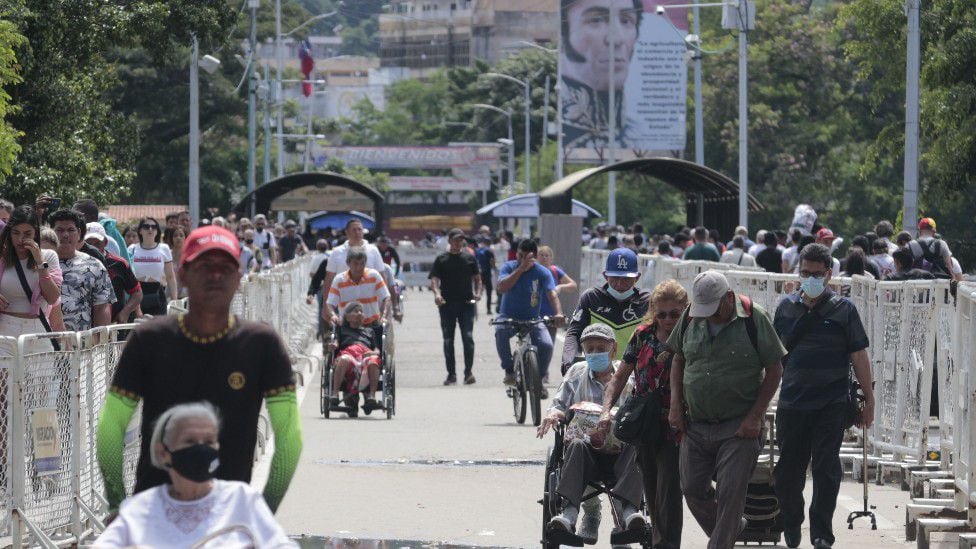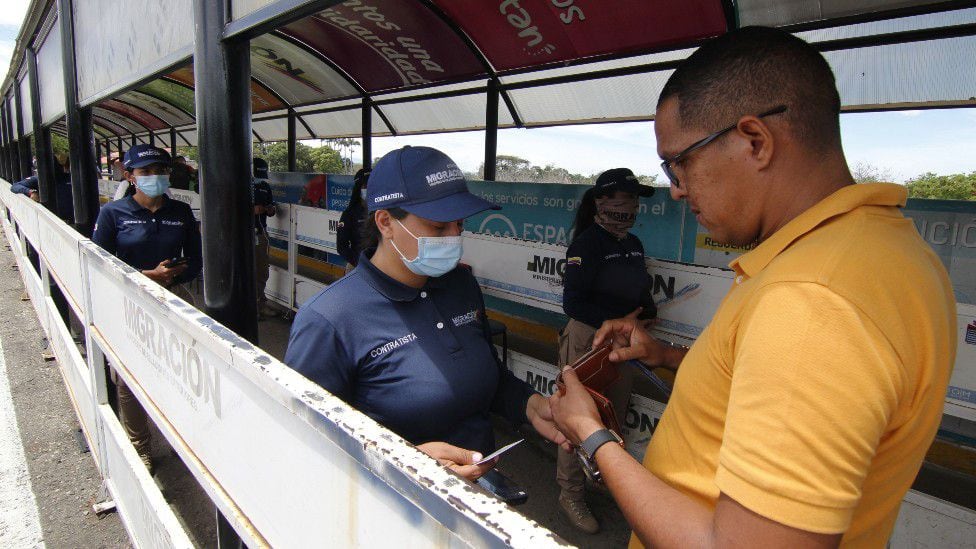With roses and white guayaberas, followed by trucks decorated with balloons and tricolor flags, on September 26, high officials of Colombia Y Venezuela They reopened the border after seven years closed.
“It is a historic day for America,” declared that day, on the Simón Bolívar bridge, the Colombian president, Gustavo Petrobefore dozens of followers who celebrated the end of a border closure that promoted illegality, violence and unemployment.
LOOK: Las Tejerías: Venezuela calculates about 100 dead in the biggest landslide in decades
Almost three weeks after the opening, the scene in this part of the border, the most important in terms of migration and trade for both countriesis different from the one lived during these seven years: you can already see cargo trucks, hundreds of passers-by and the dynamism and noise of a lifetime.
But the revival of the border is raw: the passage of trucks is sporadic, there is no passage of public or private transport vehicles and the famous trails, those informal crossings that many prefer to the official bridge, are just as valid as they were a month ago.
“What if this it’s the same as before“says Nelly Mesa, a Venezuelan who goes to Colombia every two or three days to visit relatives and buy groceries and clothes for her 7-year-old daughter, who accompanies her walking on the bridge under a stinging sun.
“What has changed is that the gandolas (cargo trucks) and people with money can now pass quietly, but in the end one has to walk,” he adds, in a complaint that is repeated among passers-by.
But the governments, and dozens of businessmen, are happy: they believe that the opening ushers in an era of commercial prosperity and that the resumption of political relations, interrupted by the former president Ivan Duke as part of a strategy to round up Nicholas Madurowill bear important fruits, among them a negotiated peace with the guerrillas of the National Liberation Army (ELN), which operates in both countries.
“What happens is that people don’t see that because we haven’t seen government announcements for years,” says Francisco Londoño, a young Colombian social and political leader in the area.
“Besides the things that exist here, from the violence to the illegality that we see every day, which are also getting worsethe opening of the border is laughable. It is hardly normal for people to wonder what they opened, if not even the pedestrian corridors of the bridges (enabled by Duque in 2020) have enough space to walk comfortably, “he maintains.
Even skeptics agree with the opening of the border. What they question is the “grandiloquence” of an event that seemed to ignore the magnitude of the challenges ahead and damage caused by closing. This is, and it is unlikely that it will stop being in the short term, one of the most chaotic borders in the world.
There is charge, but little
Víctor Méndez, executive director of the Colombian-Venezuelan Chamber, is one of many business leaders from Cúcuta, the most important city on this part of the north-central border, who pressured governments to reopen the border.
“I think that people are not aware of the damage that the closure did to us,” he says. “Only here was 35 customs companies and with the closure there were two left and now there are nine. And it’s similar with the transport companies: there were 65, there were 15 left and before the end of the year there could be up to 50.”
Like many other unionists, Méndez assures that the border must be depoliticized: “Here nobody is asking about the regime or about Petro, here the interest is merely commercial“.

Cúcuta is a right-wing city. The proximity to Venezuela, the damage caused by the guerrillas and the enterprising character of the Cucuteños made this region a bastion of uribismo. Petro lost here by a wide advantage. But, according to Méndez, “the feeling is one of hope.”
Although optimistic and satisfied with the management of the Colombian government, Méndez admits that there is still a need technical and bureaucratic adjustments so that the commercial exchange between Colombia and Venezuela lives the boom that the politicians promised three weeks ago.
Many of the trucks that have crossed into Colombia spent days in customs due to the absence of tax mechanisms, personnel and legal guarantees that would expedite their entry.
Going through the trail for many freighters is still the most agile optioneven cheap. It is difficult to know how many have crossed legally since the opening: the Colombian authorities speak of 35, the Venezuelan authorities of 25 and policemen on the two bridges told BBC Mundo things like “if 20 trucks have passed, it is a lot”.

In any case, before the closure, in 2015, they used to spend up to 100 trucks a day by these two bridges that connect Cúcuta with Venezuela.
And perhaps there is no more reliable proof that the border opening is incipient than the third bridge that was built in this area for cargo transport: Tienditas, a nine-lane highway that was completed in 2015 after decades of attempts, cost US $32 million and today could not be inaugurated.
The containers that were placed during the confrontation between Maduro and Duque in 2019 are still there. On the Colombian side, the immigration and customs buildings are ready, but in Venezuela adjustments are needed.
In the absence of trucks and people, the bridge feels like a holiday peace: the huge, empty, brand new asphalt avenues seem like the perfect setting for a car driving course.

“Condemned to the mafia of trocheros”
The flow of people over the two open bridges has undoubtedly increased: to Colombia they pass empty-handed and to Venezuela they return full of suitcases and sacks and boxes that they load on rickety wheelbarrows. Motorcycle taxis, cookies, cell phone lines, wheelchairs are offered.
Mercedes, a Venezuelan baggage handler who asked not to reveal her real name, says that the illegal practices that a month ago were concentrated on the trails, now pass through the bridge: “If they really opened the border, then why can’t people pass without rattling (bribing) a washing machine or a television that they bought legally with the bill.”
In the hours that BBC Mundo was on the bridges, he saw policemen from both countries receiving money; others letting pass if people presented the payment receipt of the good they wanted to cross.
At night the Colombian police leave. Released videos seem to show truck drivers with huge amounts of merchandise passing through and paying the Venezuelan Guard to enter.

Awilda Wanche, a 54-year-old Colombian who is walking back to her country, says that time restrictions continue to complicate her life:
“Tomorrow I have to catch a plane to Caracas in San Antonio (on the Venezuelan border) at 8AM and the border opens at 6AM. You andExplain to me how I am going to get to the flight on time without having to cross the trail“.
With bank documents in hand that she went to update before her trip, Wanche walks fast, stressed. The woman talks about armed groups that manage the trails. If before the closure of the border there were three different gangs, now the study centers count 13, including guerrillas, paramilitaries and drug traffickers.
The lady reiterates: “Then tell me how the town is going to do so as not to continue being condemned to the mafia of trocheros and the police. Tell me”.
Source: Elcomercio
I, Ronald Payne, am a journalist and author who dedicated his life to telling the stories that need to be said. I have over 7 years of experience as a reporter and editor, covering everything from politics to business to crime.

:quality(75)/cloudfront-us-east-1.images.arcpublishing.com/elcomercio/GE4DCMRNGEYC2MJTKQYDAORRHA.jpg)

:quality(75)/cloudfront-us-east-1.images.arcpublishing.com/elcomercio/6LY5F2AOONAUNOMY6W3RC7NF4Q.jpg)
:quality(75)/cloudfront-us-east-1.images.arcpublishing.com/elcomercio/B2UFBL7L3JGR3MGEUCPRHAJXAU.jpg)
:quality(75)/cloudfront-us-east-1.images.arcpublishing.com/elcomercio/QNTQNC66LNFENDRBHRAZITLJPE.jpg)
:quality(75)/cloudfront-us-east-1.images.arcpublishing.com/elcomercio/WEVTGRRWMBHQJGMNLAHHKUV2XE.jpg)
